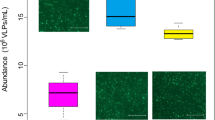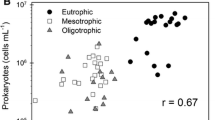Abstract
Concentrations of viruses and prokaryotes in the alkaline, moderately hypersaline, seasonally stratified Mono Lake are among the highest reported for a natural aquatic environment. We used electron microscopy to test whether viral morphological characteristics differed among the epilimnion, metalimnion, and the anoxic hypolimnion of the lake and to determine how the properties of viruses in Mono Lake compare to other aquatic environments. Viral capsid size distributions were more similar in the metalimnion and hypolimnion of Mono Lake, while viral tail lengths were more similar in the epilimnion and metalimnion. The percentage of tailed viruses decreased with depth and the relative percentages of tailed phage families changed with depth. The presence of large (>125 nm capsid), untailed viruses in the metalimnion and hypolimnion suggests that eukaryotic viruses are produced in these suboxic and anoxic, hypersaline environments. Capsid diameters of viruses were larger on average in Mono Lake compared to other aquatic environments, and no lemon-shaped or filamentous viruses were found, in contrast to other high-salinity or high-altitude lakes and seas. Our data suggest that the physically and chemically distinct layers of Mono Lake harbor different viral assemblages, and that these assemblages are distinct from other aquatic environments that have been studied. Furthermore, we found that filtration of a sample through a 0.22-µm pore-size filter significantly altered the distribution of viral capsid diameters and tail lengths, resulting in a relative depletion of viruses having larger capsids and longer tails. This observation highlights the potential for bias in molecular surveys of viral diversity, which typically rely on filtration through 0.2- or 0.22-µm pore-size membrane filters to remove bacteria during sample preparation.




Similar content being viewed by others
References
Bench SR, Hanson TE, Williamson KE, Ghosh D, Radosovich M, Wang K, Wommack KE (2007) Metagenomic characterization of Chesapeake Bay virioplankton. Appl Environ Microbiol 73:7629–7641
Bettarel Y, Amblard C, Sime-Ngando T, Carrias J-F, Sargos D, Garabetian F, Lavandier P (2003) Viral lysis, flagellate grazing potential, and bacterial production in Lake Pavin. Microb Ecol 45:119–127
Boehrer B, Schultze M (2008) Stratification of lakes. Reviews of Geophysics 46:RG2005
Bratbak G, Haslund OH, Heldal M, Naess A, Roeggen T (1992) Giant marine viruses? Mar Ecol Prog Ser 85:202–202
Breitbart M, Felts B, Kelley S, Mahaffy JM, Nulton J, Salamon P, Rohwer F (2004) Diversity and population structure of a near-shore marine-sediment viral community. Proc R Soc B 271:565–574
Breitbart M, Salamon P, Andresen B, Mahaffy JM, Segall AM, Mead D, Azam F, Rohwer F (2002) Genomic analysis of uncultured marine viral communities. Proc Natl Acad Sci USA 99:14250–14255
Brum JR, Steward GF, Jiang SC, Jellison R (2005) Spatial and temporal variability of prokaryotes, viruses, and viral infections of prokaryotes in an alkaline, hypersaline lake. Aquat Microb Ecol 41:247–260
Castberg T, Thyrhaug R, Larsen A, Sandaa R-A, Heldal M, Van Etten JL, Bratbak G (2002) Isolation and characterization of a virus that infects Emiliania huxleyi (Haptophyta). J Phycol 38:767–774
Colombet J, Robin A, Lavie L, Bettarel Y, Cauchie HM, Sime-Ngando T (2007) Virioplankton 'pegylation': Use of PEG (polyethylene glycol) to concentrate and purify viruses in pelagic ecosystems. J Microbiol Meth 71:212–219
Colombet J, Sime-Ngando T, Cauchie HM, Fonty G, Hoffmann L, Demeure G (2006) Depth-related gradients of viral activity in Lake Pavin. Appl Environ Microbiol 72:4440–4445
Culley AI, Lang AS, Suttle CA (2006) Metagenomic analysis of coastal RNA virus communities. Science 312:1795–1798
Davidson LA, Davidson AE (2005) The range of protists in Mono Lake, a hypersaline soda lake in the eastern sierras. J Eukaryot Microbiol 52:11S
Demuth J, Neve H, Witzel K-P (1993) Direct electron microscopy study on the morphological diversity of bacteriophage populations in Lake Plussee. Appl Environ Microbiol 59:3378–3384
Edgcomb V, Orsi W, Leslin C, Epstein SS, Bunge J, Jeon S, Yakimov MM, Behnke A, Stoeck T (2009) Protistan community patterns within the brine and halocline of deep hypersaline anoxic basins in the eastern Mediterranean Sea. Extremophiles 13:151–167
Finlay BJ (1990) Physiological ecology of free-living protozoa. Adv Microb Ecol 11:1–34
Garza DR, Suttle CA (1995) Large double-stranded DNA viruses which cause the lysis of a marine heterotrophic nanoflagellate (Bodo sp) occur in natural marine viral communities. Aquat Microb Ecol 9:203–210
Guixa-Boixereu N, Calderon-Paz JI, Heldal M, Bratbak G, Pedro-Alio C (1996) Viral lysis and bacteriovory as prokaryotic loss factors along a salinity gradient. Aquat Microb Ecol 11:215–227
Hofer JS, Sommaruga R (2001) Seasonal dynamics of viruses in an alpine lake: importance of filamentous forms. Aquat Microb Ecol 26:1–11
Hollibaugh JT, Wong PS, Bano N, Pak SK, Prager EM, Orrego C (2001) Stratification of microbial assemblages in Mono Lake, California, and response to a mixing event. Hydrobiologia 466:45–60
Humayoun SB, Bano N, Hollibaugh JT (2003) Depth distribution of microbial diversity in Mono Lake, a meromictic soda lake in California. Appl Environ Microbiol 69:1030–1042
Jellison R, Melack JM (1993) Algal photosynthetic activity and its response to meromixis in hypersaline Mono Lake, California. Limnol Oceanogr 38:818–837
Jellison R, Melack JM (1993) Meromixis in hypersaline Mono Lake, California. 1. Stratification and vertical mixing during the onset, persistence, and breakdown of meromixis. Limnol Oceanogr 38:1008–1019
Jellison R, Melack JM (2001) Nitrogen limitation and particulate elemental ratios of seston in hypersaline Mono Lake, California, U.S.A. Hydrobiologia 466:1–12
Jellison R, Melack JM (1988) Photosynthetic activity of phytoplankton and its relation to environmental factors in hypersaline Mono Lake, California. Hydrobiologia 158:69–88
Jellison R, Miller LG, Melack JM, Dana GL (1993) Meromixis in hypersaline Mono Lake, California. 2. Nitrogen fluxes. Limnol Oceanogr 38:1020–1039
Jellison R, Romero J, Melack JM (1998) The onset of meromixis during restoration of Mono Lake, California: unintended consequences of reducing water diversions. Limnol Oceanogr 43:706–711
Jiang S, Steward G, Jellison R, Chu W, Choi S (2004) Abundance, distribution, and diversity of viruses in alkaline, hypersaline Mono Lake, California. Microb Ecol 47:9–17
Jones BE, Grant WD, Duckworth AW, Owenson GG (1998) Microbial diversity of soda lakes. Extremophiles 2:191–200
Krebs CJ (1999) Ecological Methodology, 2nd edn. Addison-Welsey Educational Publishers, Inc., Menlo Park
Lawrence JG, Hatfull GF, Hendrix RW (2002) Imbroglios of viral taxonomy: genetic exchange and failings of phenetic approaches. J Bacteriol 184:4891–4905
Melack JM, Jellison R (1998) Limnological conditions in Mono Lake: contrasting monomixis and meromixis in the 1990 s. Hydrobiologia 384:21–39
Noble RT, Fuhrman JA (1998) Use of SYBR Green I for rapid epifluorescence counts of marine viruses and bacteria. Aquat Microb Ecol 14:113–118
Oren A, Bratbak G, Heldal M (1997) Occurrence of virus-like particles in the Dead Sea. Extremophiles 1:143–149
Paul JH, Jiang SC, Rose JB (1991) Concentration of viruses and dissolved DNA from aquatic environments by vortex flow filtration. Appl Environ Microbiol 57:2197–2204
Pina S, Creus A, Gonzalez N, Girones R, Felip M, Sommaruga R (1998) Abundance, morphology and distribution of planktonic virus-like particles in two high mountain lakes. J Plankton Res 20:2413–2421
Reisser W (1993) Viruses and virus-like particles of freshwater and marine eukaryotic algae - a review. Archiv fur Protisten Kunde 143:257–265
Roesler CS, Culbertson CW, Etheridge SM, Goericke R, Kiene RP, Miller LG, Oremland RS (2002) Distribution, production, and ecophysiology of Picocystis strain ML in Mono Lake, California. Limnol Oceanogr 47:440–452
Setala O (1991) Ciliates in the anoxic deep-water layer of the Baltic. Arch Hydrobiol 122:483–492
Sheldon RW, Sutcliffe WHJ (1969) Retention of marine particles by screens and filters. Limnol Oceanogr 14:441–444
Stopar D, Cerne A, Zigman M, Poljsak-Prijatelj M, Turk V (2003) Viral abundance and a high proportion of lysogens suggests that viruses are important members of the microbial community in the Gulf of Trieste. Microb Ecol 46:249–256
Strickland JDH, Parsons TR (1972) A practical handbook of seawater analysis. Fisheries Research Board of Canada Bulletin:167
Suttle CA (2005) Viruses in the sea. Nature 437:356–361
Van Etten JL, Lane LC, Meints RH (1991) Viruses and viruslike particles of eukaryotic algae. Microbiol Rev 55:586–620
Walker KF, Williams WD, Hammer UT (1970) The Miller method for oxygen determination applied to saline lakes. Limnol Oceanogr 15:814–815
Weinbauer MG, Hofle MG (1998) Significance of viral lysis and flagellate grazing as factors controlling bacterioplankton production in a eutrophic lake. Appl Environ Microbiol 64:431–438
Weinbauer MG, Peduzzi P (1994) Frequency, size and distribution of bacteriophages in different marine bacterial morphotypes. Mar Ecol Prog Ser 108:11–20
Wommack KE, Colwell RR (2000) Virioplankton: viruses in aquatic ecosystems. Microbiol Mol Biol Rev 64:69–114
Zar J (1996) Biostatistical Analysis, 3rd edn. Prentice Hall, Upper Saddle River
Acknowledgements
This research was supported by grants from the US National Science Foundation (DEB 01-29174, OCE 04-42664, EF 04-24599). We thank Robert Jellison for providing logistical support in the field, hydrographic data, and review of this manuscript. We further acknowledge the logistical support provided by the Sierra Nevada Aquatic Research Laboratory through the University of California Natural Reserve System. We thank Tina Carvalho of the University of Hawai‘i Biological Electron Microscope Facility for her assistance with TEM. We also thank David Karl for reviewing and providing comments on a draft of this manuscript.
Author information
Authors and Affiliations
Corresponding author
Rights and permissions
About this article
Cite this article
Brum, J.R., Steward, G.F. Morphological Characterization of Viruses in the Stratified Water Column of Alkaline, Hypersaline Mono Lake. Microb Ecol 60, 636–643 (2010). https://doi.org/10.1007/s00248-010-9688-4
Received:
Accepted:
Published:
Issue Date:
DOI: https://doi.org/10.1007/s00248-010-9688-4




